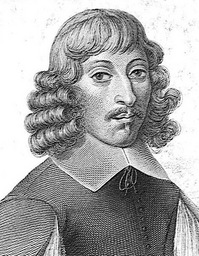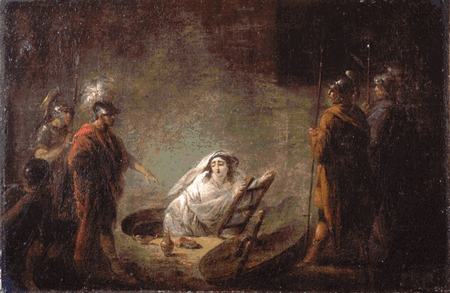The Story of Mother Mectilde and the Vocation of Perpetual Adoration, Part II
This is part II in our series of articles about how Mother Mectilde began the life of the Benedictines of the Perpetual Adoration. Click here for part I.
The painting above, by Jacques Gamelin, depicts a vestal virgin being punished for some infidelity. Curiously, it was a painting of this type that caused Catherine-Mectilde de Bar to ask why there was no monastery in the Church dedicated to tending the perpetual fires of adoration and love before the Most Holy Sacrament of the Altar.
On the Move Again
It became evident that Mother Mectilde’s little community would have to find a house better adapted to monastic observance than their somewhat makeshift lodgings in the hospice of Le Bon Ami in the rue du Bac. Several offers came her way: among them were a priory at Vire in Normandy; a convent in Paris that would amalgamate all the homeless and wandering religious of the capital; a proposed foundation in the suburb of Saint-Marcel that would be connected with the Jansenist community of Port-Royal. Mother Mectilde refused all these, in particular the connection with Port-Royal. She would have nothing to do with the Jansenists. The gentlemen of Port-Royal, miffed by her refusal, cut off all donations to Mother Mectilde’s community.
The Idea of Perpetual Adoration
While all of this was going on, one Abbé Gontier, treasurer of the Sainte-Chapelle of Dijon and vicar general of Langres, proposed to Mother Mectilde that she should establish perpetual adoration of the Most Holy Sacrament in her monastery. This worthy priest had, of his own initiative, established in all the parishes of his diocese the recitation of an amende honorable — we would say an act of reparation — every Thursday. This amende honorable was read by a priest, kneeling before the monstrance, and holding a lighted taper in his hand. Mother Mectilde found the idea attractive. Elements of the practice were later incorporated into the ritual of the Benedictines of the Most Holy Sacrament. Mother Mectilde proposed the practice to a group of noble ladies, all friends of hers who, influenced by Monsieur de Bernières, saw in the project a means of keeping Mother Mectilde in Paris.
A Strange Painting and Its Effect
Then something very curious happened. One day when Mectilde was visiting her friend, Madame de Boves, she noticed a painting that depicted ancient pagans rendering homage to an idol set upon an altar. A pagan priest surrounded by priestesses knelt in adoration, holding lighted candles in their hands. A sacred fire was burning in the background, tended by vestal virgins, while in the distance torturers were punishing negligent virgins. (The vestal virgins were a group of priestesses in ancient Rome dedicated to the service of Vesta, goddess of the hearth. Vestal virgins who neglected the sacred fire or violated their vow of chastity were severely punished.)
However bizarre one may find all this, the Spirit of God used it to touch Mother Mectilde’s heart. A short while before this incident, a priest had said to her, “Rejoice, because God intends to use you to accomplish something very great for the honour of the Most Holy Sacrament. Prepare yourself. God revealed this to me during Holy Mass.”
Idolators Will Rise Up to Judge Us
As Mectilde contemplated the strange painting, the prophetic words of the priest came back to her. She began to think, “By means of this idolatrous work of art, God is inciting me to an assiduous presence before the tabernacle, that he might be adored at all hours of the day and night.” Turning to the Marquise de Boves, she said, “Madame, the idolators will one day rise up to condemn us, for we Christians show such little respect for the Blessed Sacrament in our churches. Alas! Shall we not do for our God what the pagans did for their false gods? Why, in the house where God continually dwells, is He not continually adored? Why do not virgins here on earth sing unceasingly the canticle of the Angels before His altars? Why do the sentinels of Israel not keep watch, by day and by night, before the throne of the New Solomon of the New Law?”
Prophecies and Visions

Mother Mectilde, in pronouncing these words, was not unaware of the predictions made by a number of mystics known to her. Barbe, a poor maidservant of Compiègne, directed by none other than the great Father Charles de Condren, successor to Cardinal Bérulle as Superior General of the French Oratory, had prophesied: “There will come a time in which there will be religious totally dedicated to the adoration of the Most Holy Sacrament.” Monsieur Gaston de Renty, one of the outstanding spiritual figures of Normandy, had said, “Very soon there will be an institute of religious wholly dedicated to the worship of the Most Holy Sacrament. They will be chosen souls.” And, in Paris itself, Marie de Gournay, a wine merchant’s wife, had a vision in which she saw the future monastery, and heard the words, “Behold the work of my servant Catherine.”
God Provides Funding
Mother Mectilde’s reflection on the painting so struck Madame de Boves, a woman already animated by a fervent Eucharistic piety, that she resolved to do all in her power to promote the foundation of a monastery of perpetual adoration. Together with the Countess of Châteauvieux, and Madames Cessac and Mangot, she raised a total of 31,000 pounds for the establishment of a monastery of reformed Benedictines in which, “ceaselessly, by day and by night, the Most Holy Sacrament of the Altar would be adored to make reparation, insofar as possible, for the lack of respect, indifference, profanations, sacrileges, and offenses committed against this most adorable Sacrament.”
A Charism, A Mission
These Benedictine adorers would, further, beg God to take pity on France, to grant peace in its borders, and to protect the King. Their mission would be to make up for the failure of so many souls to show reverence for the Most Holy Sacrament, either by ignorance or malice. They would adore Jesus Christ truly present in the Sacrament of His Love for the sake of those who do not adore, or refuse to adore, or never thinking of pausing in adoration before Him.

It is significant that for Mother Mectilde and indeed for the Church of her time, Eucharistic adoration was not synonymous with exposition of the Most Blessed Sacrament in the monstrance. Exposition was reserved for special occasions, marked by a festive solemnity and by a loving display of artistry and beauty in homage to the Eucharistic King. The practice of exposition on Thursdays transformed every Thursday into a weekly feast of Corpus Christi. On ordinary days, the perpetual adoration was carried out before the closed tabernacle, mindful of the words of the prophet Isaias, Vere tu es Deus absconditus, Deus Israel Salvator; “Truly Thou art a hidden God, O God of Israel, the Saviour.” (Isaias 45:15)
The new monastery would bind itself to the celebration of the Mass and Office of the Most Blessed Sacrament (that of the feast of Corpus Christi) every Thursday, and to exposition of the Blessed Sacrament in the monstrance until the end of Vespers on Thursday as well. A touching detail: in addition to the oil lamp burning before the Most Holy Sacrament, they promised to keep a lamp burning before the image of the Blessed Virgin Mary every Saturday.
Thus did the form and spirit of the new monastery begin to emerge from the hearts of Mother Mectilde and her friends: to adore and make reparation for the indifference of so many Christians to the Sacrament of Our Lord’s Love. Mother Mectilde promised to execute the project within two years’ time.
To be continued.
Share this:
- Click to share on Twitter (Opens in new window)
- Click to share on Reddit (Opens in new window)
- Click to share on Facebook (Opens in new window)
- Click to share on Pinterest (Opens in new window)
- Click to share on X (Opens in new window)
- Click to share on WhatsApp (Opens in new window)
- Click to print (Opens in new window)

